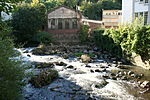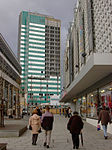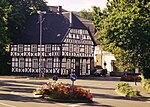Hagen-Heubing station

Hagen-Heubing station is a through station in the city of Hagen in the German state of North Rhine-Westphalia. The station was opened along with a section of the Düsseldorf-Derendorf–Dortmund Süd railway, opened by the Rhenish Railway Company (German: Rheinische Eisenbahn-Gesellschaft, RhE) between Wuppertal-Wichlinghausen and Hagen RhE station (now Hagen-Eckesey depot) on 15 September 1879. It was closed on 14 May 1950, but reopened in 1968. It has two platform tracks and it is classified by Deutsche Bahn as a category 6 station.The station is served by Rhine-Ruhr S-Bahn line S 8 between Mönchengladbach and Hagen and line S 9 between Recklinghausen and Hagen, both every 60 minutes.The station is also served by four bus routes operated by Hagener Straßenbahn AG: 510 (every 15–30 minutes), 525 (30), 528 (30) and 532 (60).
Excerpt from the Wikipedia article Hagen-Heubing station (License: CC BY-SA 3.0, Authors, Images).Hagen-Heubing station
Am Hasper Bahnhof, Hagen Haspe (Haspe)
Geographical coordinates (GPS) Address Nearby Places Show on map
Geographical coordinates (GPS)
| Latitude | Longitude |
|---|---|
| N 51.352346 ° | E 7.424515 ° |
Address
Park-and-Rail Heubing
Am Hasper Bahnhof
58135 Hagen, Haspe (Haspe)
North Rhine-Westphalia, Germany
Open on Google Maps










